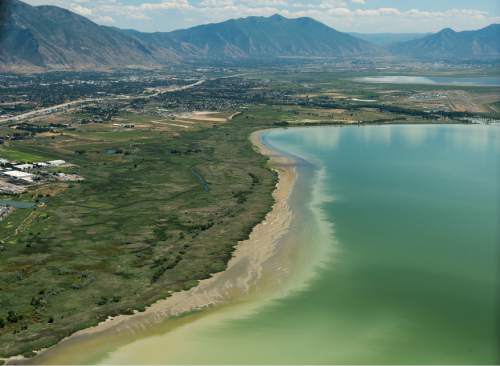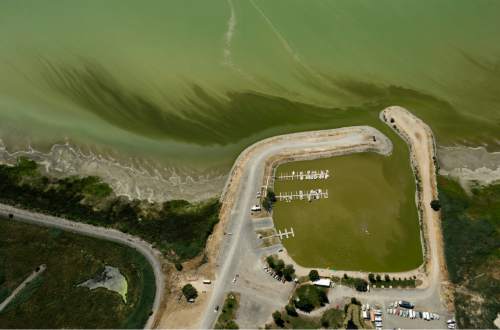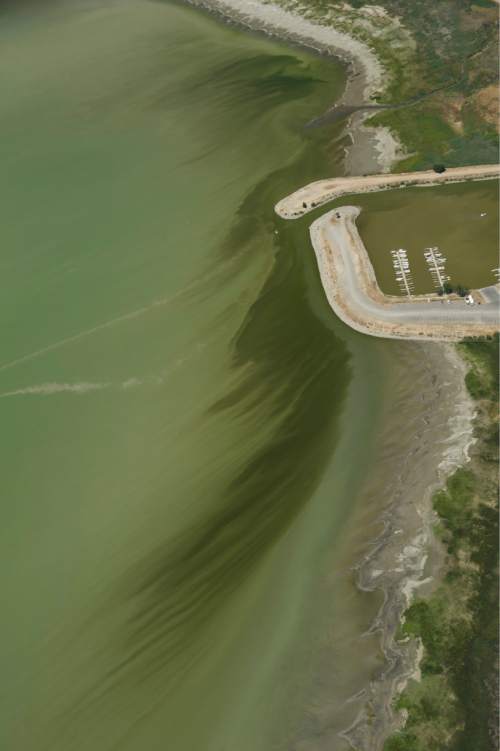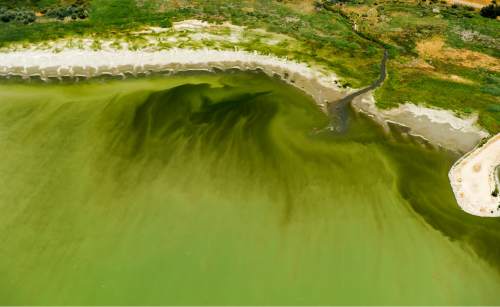This is an archived article that was published on sltrib.com in 2016, and information in the article may be outdated. It is provided only for personal research purposes and may not be reprinted.
Salt Lake County officials are exploring the possibility of declaring a state of emergency due to the ongoing algal bloom in Utah Lake and the Jordan River.
Steve Sautter, manager of Salt Lake County Emergency Management's Joint Information Center, said county officials have spoken with state leaders about the possibility of declaring an official emergency, which could give the state access to federal funds to pay for damage associated with the bloom.
The presence of cyanobacteria — the poisonous organisms responsible for the bloom — in Utah Lake, the Jordan River and associated Salt Lake County canals continues to interfere with the availability of irrigation water in Salt Lake, endangering farmers' crops and livestock.
The Utah Department of Agriculture and Food has warned farmers against using water sourced from the Utah Lake and the Jordan River to water crops and livestock. That warning has prompted many providers of secondary irrigation water to shut down their systems.
Salt Lake County has set up a hotline intended for commercial farmers who need access to an alternate source of water for their livestock. Those with animals that do not have access to adequate clean water may call 801-743-7045 to request assistance.
But the county is less able to assist those at risk of losing crops this summer, Sautter said.
"Crops are a huge issue we'll have to look at," he said. "But from the standpoint of how much water that would take, I don't think that will be something we will be able to provide."
Whether Utah declares a state of emergency would depend at least partly on the estimated value of damage to crops and livestock as a result of the algal bloom.
"Right now this is a situation that is focused primarily on just two counties," Sautter said. "I think all the county agencies are watching very carefully right now, trying to get an idea of how long this is going to go on, and what some of the consequences could be."
In addition to the impact on farmers, Utah Poison Control has received more than 500 calls related to people or animals exposed to contaminated water. Sherrie Pace, a public information officer for the Utah Poison Control Center, said about 120 of those calls involved a person who was experiencing symptoms associated with exposure to the toxins produced by cyanobacteria — gastrointestinal distress, followed by headache and a rash. There is no way to know definitively whether the symptoms were caused by the bloom, Pace said. Other calls were related to animals, requested information only or did not involve symptoms associated with cyanobacteria.
Meanwhile, the state Division of Water Quality has detected low levels of cyanobacteria in Davis County. Erica Gaddis, assistant director of the Utah Division of Water Quality, said all of the samples collected north of 3900 South contained less than 20,000 cyanobacteria per milliliter — the threshold at which these species, which are present naturally in most water bodies, are considered a health risk.
Because the state does not regularly test the Jordan River for cyanobacteria, Gaddis said there is no way to know whether the samples collected earlier this week represented the river's normal conditions, or whether levels of toxic species were elevated in connection with the bloom upstream.
However, the division is concerned that the species associated with the bloom are traveling with the river's current, and that concentrations of the algae, and the toxins they produce, could increase with time.
Green foam bubbling out of a Bluffdale storm drain, connected to Welby Canal, caused some anxiety for residents, but Salt Lake County Health Department spokesman Nicholas Rupp said it was "very likely" moss and not toxic algae.
Gaddis said it typically takes eight days for water from Utah Lake to traverse the Jordan River. The current algal bloom was first seen growing in Utah Lake on July 13.
Gaddis said the Division of Water Quality collected additional samples from Utah Lake on Wednesday to get a sense for whether the number of cyanobacteria there is growing or decreasing. But based on aerial observations above the lake, she said, the bloom so far appears unchanged.
Twitter: @EmaPen















